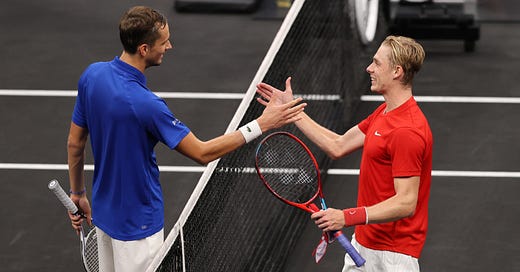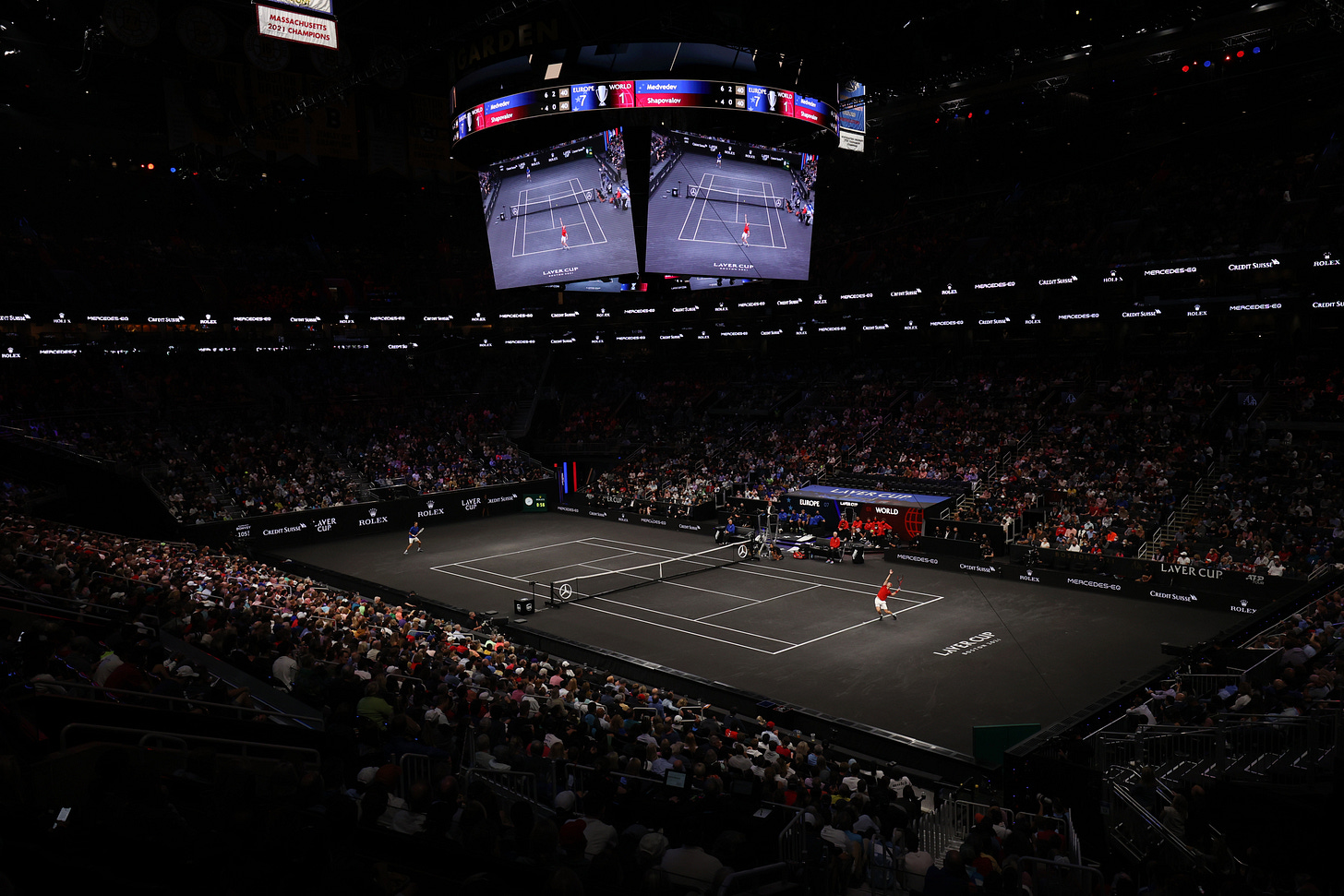I like the Laver Cup. Actually I really like it. The premise and execution is, in parts, brilliant with its bench interaction and team focused fun the standout feature. All alongside the considerable achievement of creating a tennis team competition that the players have deeply cared about from day one of its first edition in 2017. I don’t like the fact it counts in official ATP head-to-head records (mostly because it uses a different deciding set format to the regular tour and there’s an exhibition feel to the whole event), nor do I like the cascading importance of points by day. But the Laver Cup at its best is a wonderful celebration of tennis camaraderie in a chronically individual sport, and a spectacle that I think is probably more interesting and engaging in some ways to newer fans than some of the more traditional, regular events. I think the Laver Cup is important and should be viewed a bit like an incubator for the future of tennis, if the organisers could get a bit more loose with broadcast and format innovation and experimentation. It’s also been nice to see the younger generation dominate the European roster this year with the Big 3 of Federer, Nadal and Djokovic all absent through injury or fatigue, and to see doubles on such a big stage (even if the doubles can be a bit hit or miss at the Laver Cup considering it’s almost entirely singles players).
But, the Laver Cup does have a problem. Team Europe is too good for Team World, and there isn’t much indication this is going to change any time soon. Through four editions, including this year, Team Europe is undefeated. There have been close-ish years, with 2019 narrowly finishing 13-11 in Europe’s favour. But 2021 represents the most lopsided result yet — a 14-1 thrashing. There’s a good argument that the current iteration of Team Europe are actually stronger without the Big 3, largely because those older legends are usually pretty burned out by this week of the season and struggle to play their best tennis, whereas the younger cohort in 2021 looked comparatively fresh. Team World also really missed the doubles prowess of Jack Sock this year (he was their MVP in each of the previous years).
The reasons are fairly obvious.
Average ranking for the 2021 Laver Cup:
Team World: 29 (if you exclude Kyrgios, who skews the avg with his No.95 rank, it’s 16)
Team Europe: 5 (with no players outside the Top 10 and four of the Top 5)
Doubles is important in the Laver Cup, but there are three singles matches for every one doubles match so it’s much less influential to the final result than singles. However I do think that if Jack Sock had been picked for Team World the score would have been closer than the drubbing we got.
But the more precise problem, which is obviously correlated to their ranking, is the large performance gap in the return ability of Team World and Team Europe.

Day one featured a pair of extremely close matches — Team World’s Schwartzman and Auger-Aliassime (two out of the three best players for team world this weekend) could very easily have won their matches against Rublev and Berrettini respectively. A point or two was the only difference in each contest. But those weren’t bad matches to lose considering Day 1 matches are only worth one point. Team World went into Day 2, what turned out to be the crucial day, with only a 1-3 deficit after they won the doubles on the opening day. Day two is where Team World decisively lost the Laver Cup, and the chasm of ability was most exposed…
Tsitsipas beat Kyrgios 6-3, 6-4
Zverev beat Isner 7-6(8), 6-7, 10-5
Medvedev beat Shapovalov: 6-4, 6-0
These three singles match wins gave Team Europe six points and made a Team World comeback look unlikely. The Tsitsipas vs Kyrgios and Medvedev vs Shapovalov matches were routine, with Tsitsipas and Medvedev picking apart their opponent’s serves (Tsitsipas returned better than usual on this slow-ish hard court) and holding their own serves with, for the most part, ease. And the Zverev vs Isner match, despite coming down to a 3rd set tiebreaker to ten points, was decisively won by Zverev grabbing two mini breaks with good returns of serve in that tiebreaker, while Isner had no such reply. Zverev didn’t lose a single point on serve in the breaker and just had to look after his lead. Isner didn’t serve badly in the tiebreak, or the match as whole. In fact the American served damn well. But Zverev has a good return and Isner doesn’t. And over enough points if two players have similar serving advantages, but a gulf in return ability, the better returner will win. All the more so during pressure points (all tiebreaker points are pressure points) which, as we talked about last week, are on average longer and less dominated by short service points (ie further away from Isner’s happy place).
There were some bright spots for Team World. Auger-Aliassime and Diego Schwartzman both played well, and also returned well, despite losing incredibly close matches. But for most of this year’s Laver Cup, Team Europe looked like the far more balanced team. And while it’s easy to just simplistically put this down to the large ranking differential between the two teams, the more specific advantage that helps Team Europe’s player’s is their comparative well-roundedness on both serve and return compared to the serve-heavy and return-light Team World. Tsitsipas and Berrettini are not great returners, far from it, but they’re certainly better than Isner, Opelka and occasionally Shapovalov. And Ruud and Rublev are far from slouches on return. Of course this is all really just a shameless opportunity to call back this analysis from a few weeks ago: The New Playstyle Approaches…
Medvedev and Zverev are certainly leading the movement of the ‘Big Serving Counterpuncher’ but my more meta point about return of serve representing a bigger and rarer edge in an environment where big serving is pretty much a given at the elite level, still rung very true at this years Laver Cup. Team World better hope they have some young, great returners with a bit more balance to their games waiting in the wings for future years. Auger-Aliassime could grow to fit that bill and has shown some good signs this weekend and season in general, but he’s going to need some help.
Otherwise it could be an easy decade of wins for the Europeans.
— MW
See you on Thursday.
Twitter @MattRacquet
Top and Bottom: Clive Brunskill/Getty
// Looking for more?
Most recent:







I checked in a few times to watch, and kept abreast of the outcomes, but for me the Laver Cup is just not compelling enough to warrant organizing my days around watching. That could just be me.
I do think it compares well, and in a good way, to the regular weekend matches between the best players at clubs around the world: they all know each other's games, play knowing they're less than sanctioned (sic) matches, really want to win, can have fun, cheer each other on, and are comfortable enough with the format to have beers together afterwards. So in that sense, all good imo.
Any opinions, Matthew, on why the return differential?
To be honest it hasn't grabbed my attention this year (or really, any year, although I did watch the odd match), and I'm not really sure what it's USP is. If it's trying to showcase the fun, futuristic, relaxed side of tennis, I think it would sell itself much better it was a joint ATP - WTA event (which would also allow more doubles plus mixed doubles, generally more fun/relaxed events). We also might be moving into an era where the biggest WTA names are much closer in global profile to the ATP's, so bringing them alone might help attract more viewers in more markets. I really enjoyed the Hopman Cup, so I'm biased, but I think there's something in that approach.
If it's trying to be the most elite men's team competition, I don't think the draft rules or format help it. As you observe, Europe is just much stronger (and some selection decisions seem to be about marketability more than performance). The format also results in the early matches being trivial, and close matches ending too quickly. Would have been better to have given the captains an open draft, make each match roughly of equal importance, and make them normal length (or vary length depending on match importance).